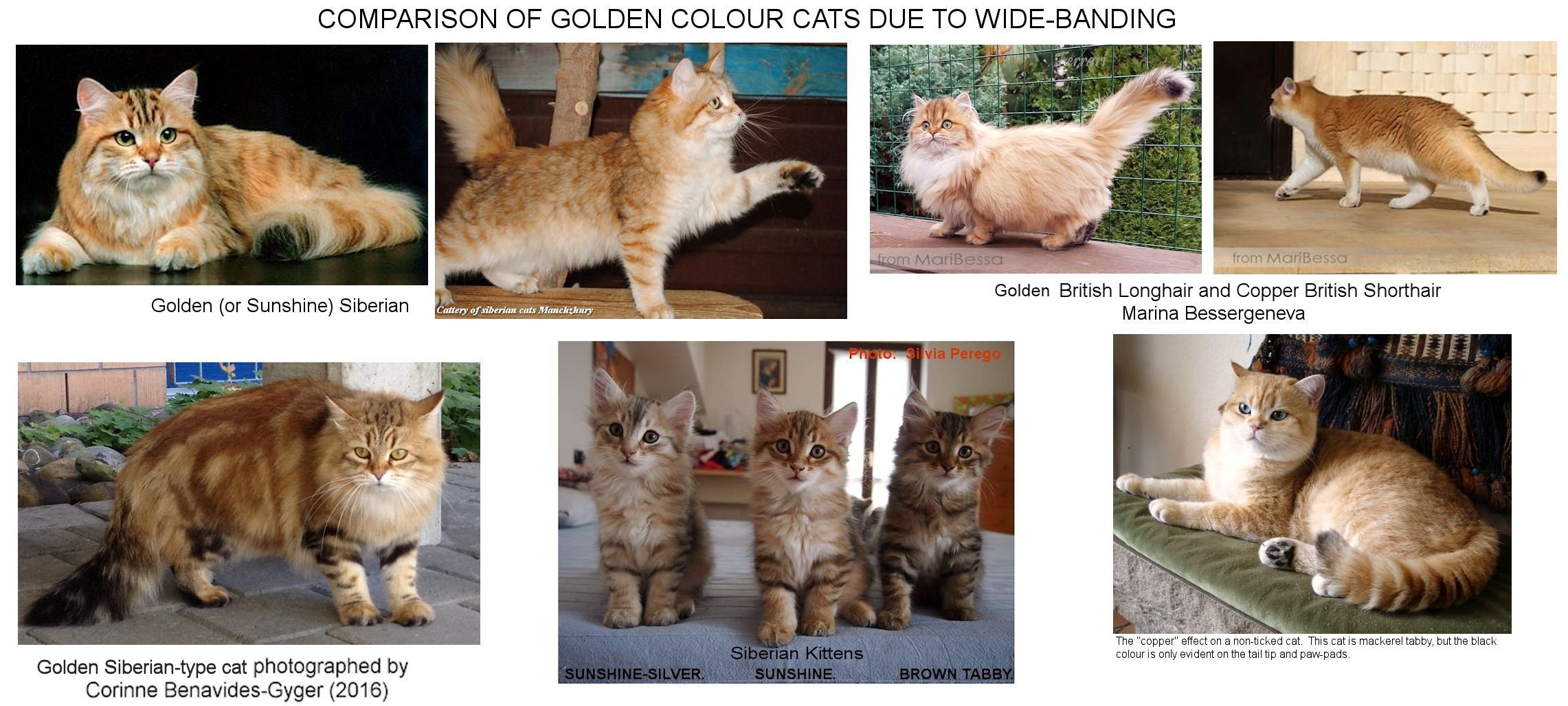
WIDE BAND GOLDEN: THE WIDE BAND CONUNDRUM IN VARIOUS BREEDS
This page pulls together investigations and theories into the role of wide band genes in different breeds and its role in Copper/Flaxen Gold/Light Gold/Extreme Golden British Shorthairs, Golden (Sunshine) and "Bimetallic" Siberians and in the Golden Tiger. Rather than duplicate information on multiple pages, this page will concentrate on the genetics and phenotype rather than the history and pedigrees. Information has been provided by Suzanna Multhaupt (Berlin, Germany – Dorofei Siberian Cats), Linda Petersson Wahlqvist (Gothenburg, Sweden), Marina Bessergeneva (Volgodonsk, Russia – Golden River Cattery).
Copper = akita/urajiro = light gold = flaxen gold = British sunshine (there are multiple names for this mutation in British Shorthairs/Longhairs, the older term "CORIN gold" was dropped as further CORIN mutations were identified).)
In brief, there are only two pigments in cats: red (phaeomelanin) and black (eumelanin) which are laid down in alternating bands on ticked hairs or along the whole length of non-ticked hairs. All other colours are due to dilution (causing misshapen pigment molecules) or degrees of reduced pigmentation. Rufism is the reddish tint found on eumelanin-based silvers where phaeomelanin bands are not completely suppressed by the Inhibitor gene. There are currently no DNA tests for silver, gold or rufism.


In tipped animals, the (poly)genes for ever wider "wideband effect" have been selectively bred for a long time. Chinchilla and Silver Tabby Persians have been selected for the most extensive white basal zone of the hair for around 150 years.
In the Siberian breed, breeders have worked for around 100 years to achieve maximum expression of Agouti. Therefore, in the Siberian and similar breeds, the kittens are born black and blossom into gold as they develop their adult coat.
In the British and Persian (tipped), kittens are born light-gold, almost milky white. As they matured they became brighter and the colour became more saturated. The kittens with the whitest underparts appeared to become the brightest coloured adults.
Research Programmes: Silver and Golden at Lyons Feline Genetics Laboratory
Phaeomelanin – red/orange/yellow pigment
Eumelanin – black-based pigments (black, blue, chocolate, lilac)
Copper – informal term previously used to describe a particular phenotype in British Shorthairs, now known as Light Gold in WCF
Sunshine – gene for Siberian Golden, different from from Persian/British Golden
UU – hypothetical gene/polygene complex that modifies ticked tabby pattern
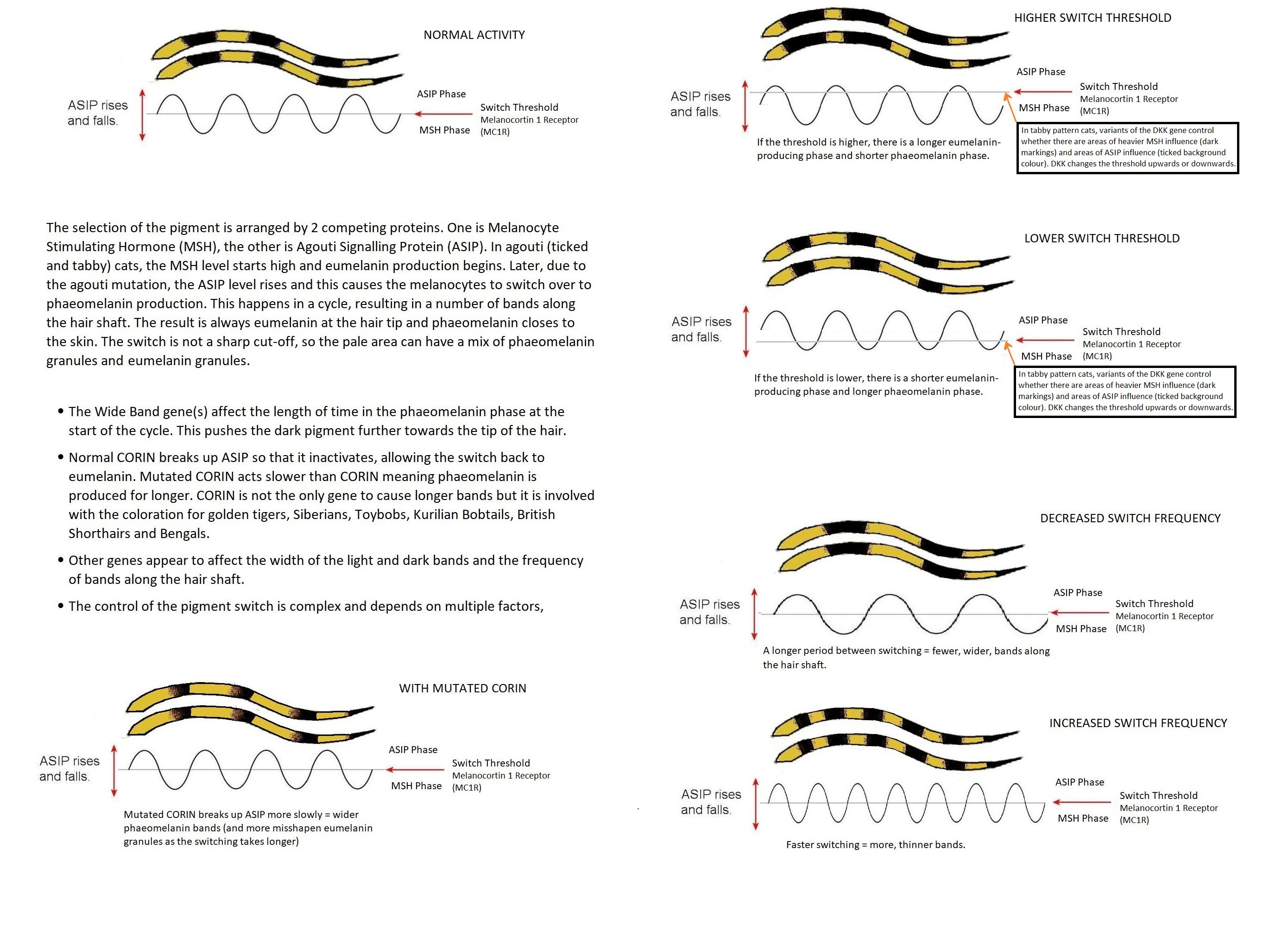
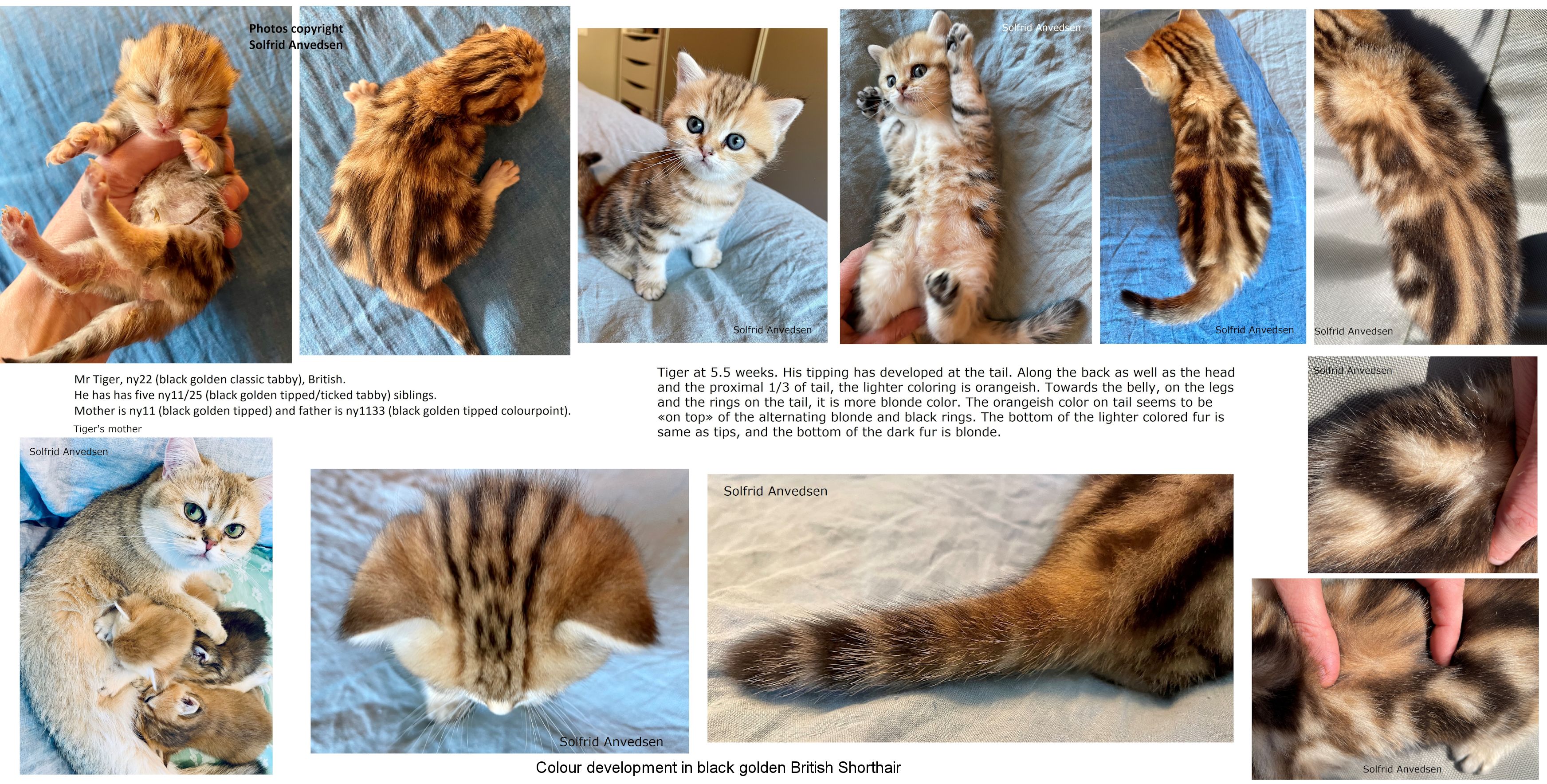
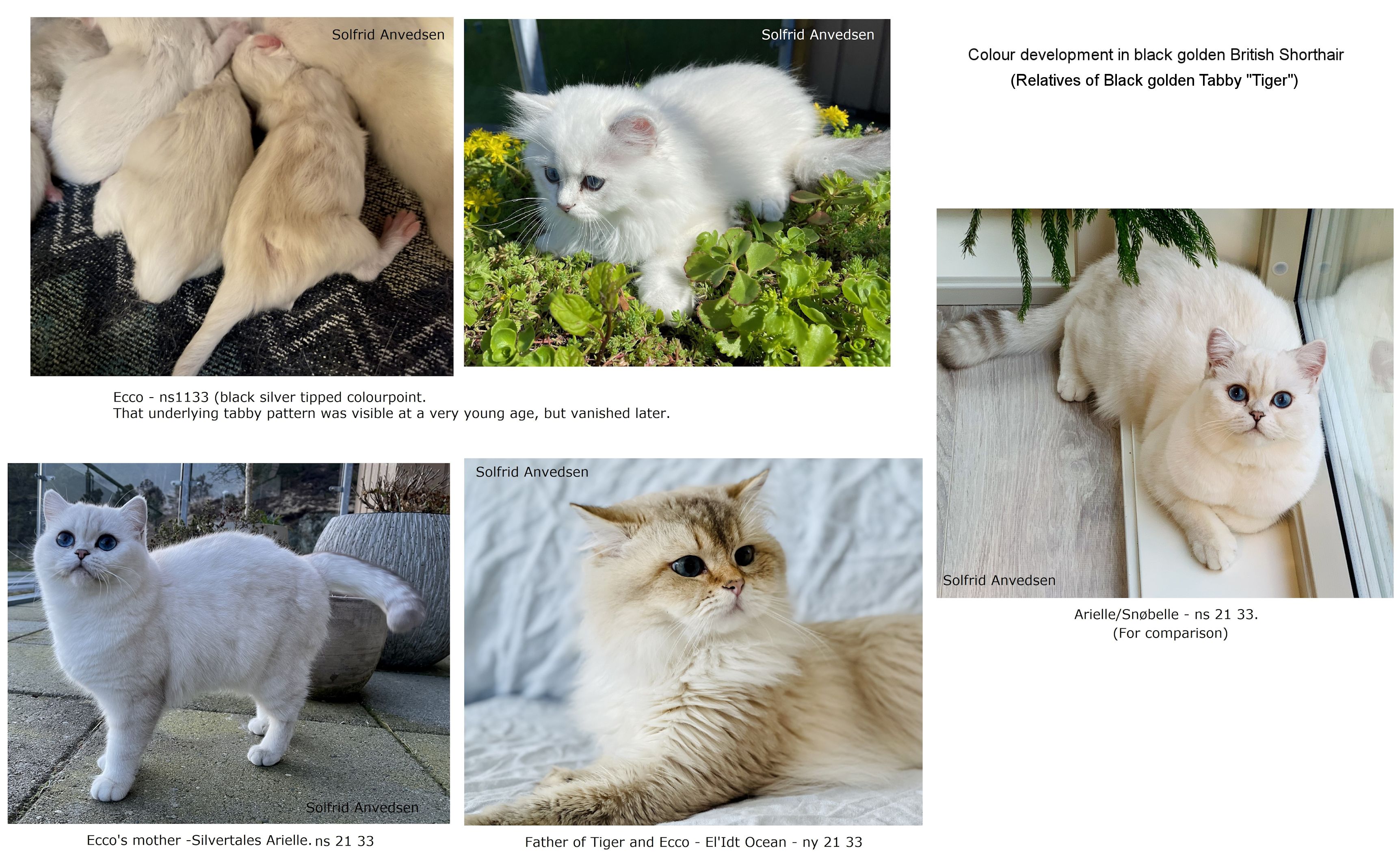
INHIBITOR GENE AND WIDE BAND “GENE”
At least two different genes are suspected of influencing the silver and golden coat colours found in many cat breeds. Interactions with other genes, and polygenes modify the effect. A dominant silver inhibitor gene is known to exist but the mutation causing it has not yet been identified The dominant Silver (Inhibitor (I,i) reduces or eliminates phaeomelanin (yellow pigment) production in the cat’s hair. On agouti hairs there are dark bands, but the light bands are changed from yellowish to white.
Wide-band (Wb) affects the length of the bands on agouti hairs. It’s more accurate to call it an effect rather than a gene. It is very variable, causing many short bands or fewer longer bands. Breeders have selected for fewer longer bands. Cats with fewer longer bands appear as chinchillas in silver cats and as goldens in non-silver cats. The wide-band effect is recessive. Several mutations of the CORIN gene cause wide-band effects in different breeds. Variable Wb effects may be due to multiple genes at different loci (positions on chromosomes) as shown below.
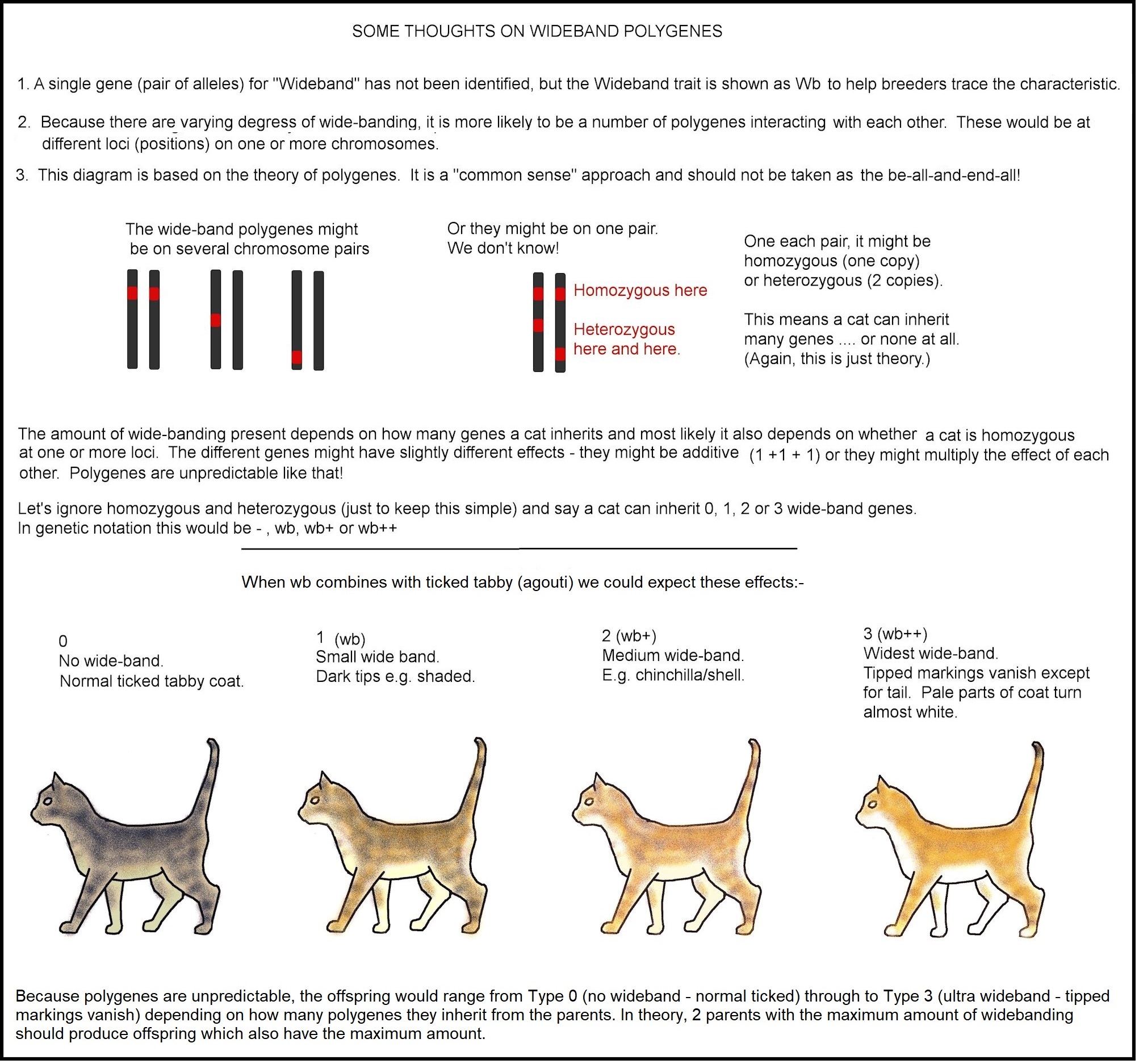
Ticked Tabby masks any other tabby patterns. Ticked Tabby without Wb gives the pattern found in Silver Abyssinians. Ticked Tabby + Wb gives Chinchillas. Ticked Tabby with extreme wide-banding gives very pale Chinchillas, almost pure white. When Ticked Tabby is absent, the tabby pattern shows up. Silver Tabbies have the Inhibitor Gene. Golden Tabbies have Wb but no Inhibitor, giving a golden background with darker markings.
Good quality tipped cats are ticked tabbies, but they have the lower dark part of the hair erased of colour by Wb + UU. This means tipping is a kind of ticking. Another observation is that two homozygous ticked tabbies do not produce tipped offspring. Tipping is semi-dominant even over ticking. Those that combine ticking and tipping are sometimes nicknamed "hedgehogs" and it can be difficult to understand which colour is ticked or tipped.
GENETIC BASIS OF GOLD COLOUR IN SIBERIAN, BRITISH SHORTHAIR/LONGHAIR, KURILIAN BOBTAIL AND MAINE COONThe genetic basis of the gold colour is the same for the Siberian breed and the British Shorthair, Kurilian Bobtail and the Maine Coon, but there is a wide variety of transitional forms and the interaction of agouti with inhibitor and/or various polygenes gives the wide variety of golden colours (though some breeders refuse to accept that "ultra" phenotypes exist). The agouti gene consists of 5 structural units (domains), only one of which directly encodes a protein that blocks the receptors, and 4 other regulate its expression. In particular, one of those domains contains a promoter ("trigger" gene element), responsible just for the cyclicity of gene activity. Another domain contains a promoter that determines the selective dorso-ventral activity of the Agouti gene. In other words, the activity of this gene in the cells of the hair follicles on the spinal surface of the animal’s body is lower than on the abdominal surface. This means that the dorsal part of the body is dominated by ticked fur, and the abdominal surface is dominated by a lighter (phaeomelanin) fur. Point mutations of the Agouti gene complex cause an increase in the amount of black pigment (the so-called hypomorphs and amorphs) are usually recessive in nature and can be multiple mutations.
As a result there is a wide array of completely different colours: yellowish-brown, brown, yellowish-grey, charcoal-grey, even olive. The markings can be high-contrast or low-contrast against the background colour. Chest, abdomen and inner sides of the legs can be light yellow, reddish or pale grey. The zoning of hairs presents a variety of options: Shorthair cats usually have either one (or occasionally two) yellow band on the hair or have a combination of yellow and grey bands. Long haired cats up to 8 yellow bands on the hair. The hairs of the markings and the background also varies, ranging from pure-black hair to yellow or grey-yellow-grey in some areas.
CORIN GENE & WIDE BAND GENOTYPES IN TIGERS
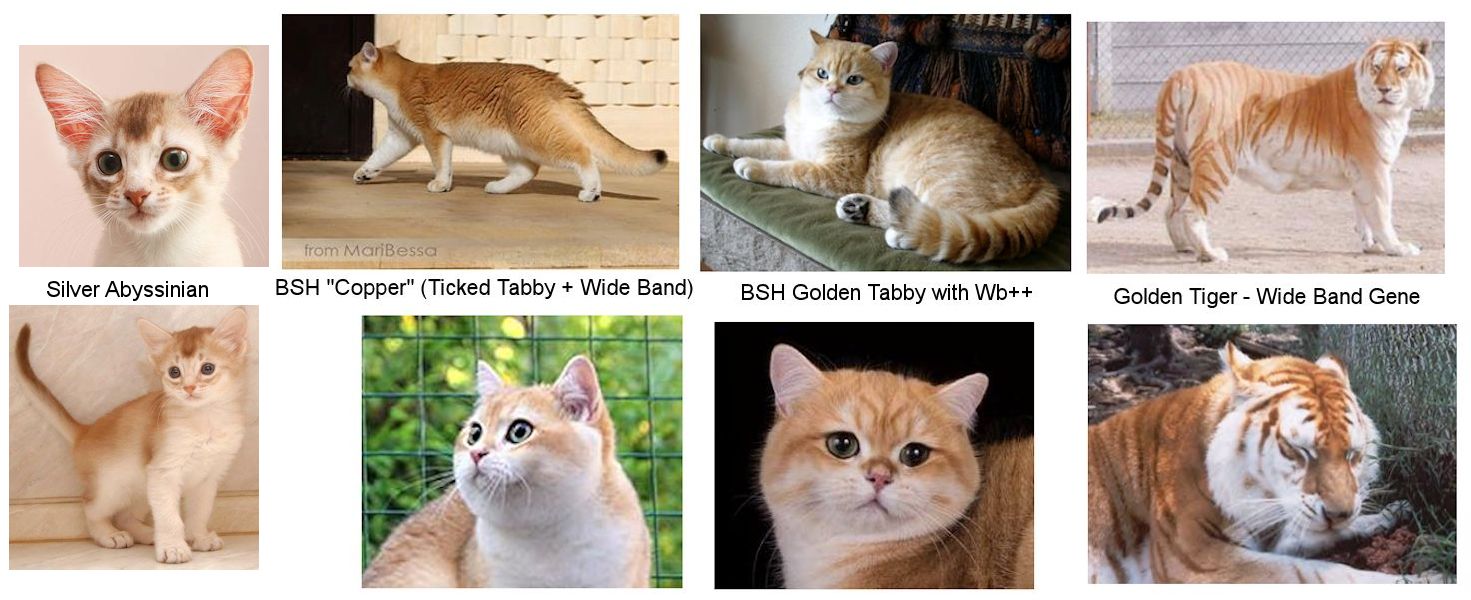
In Cell Research, 10 March 2017, a letter entitled The Genetics Of Tiger Pelage Colour Variations written by Xiao Xu, Gui-Xin Dong et al described Wideband in tigers. The white tiger coat is due to an autosomal recessive gene on the W locus i.e. white tigers are genotype w/w. This is different from the dominant Inhibitor gene found in domestic cats. The golden colour is an autosomal recessive trait called Wideband, referring to a wider central part of the hair shaft. Golden tigers are therefore wb/wb genotype. Stripeless white tigers are recessive for both of these genes i.e. w/w, wb/wb.
The mutation called p.A477V in gene SLC45A2 switches the background colour of agouti hairs from normal orange to white. On orange tigers, the agouti hairs have dark tips and bases and bands of phaeomelanin in between. On golden tigers, the agouti hairs have dark tips and bases, but have much wider bands of pale colour and narrower bands of red pigment between them. Where the stripes are reddish brown rather than black, it appears that wideband has extended the phaeomelanin synthesis phase during the hair growth cycle. In domestic cats an extension gene is also posited for this effect. In 2017, the only confirmed mammalian wideband gene was a mutation of the Agouti Signalling Protein (ASIP) gene. ASIP causes switching between eumelanin and phaemelanin production during hair growth. It was not known whether ASIP was the wideband gene in golden tigers.
A mutation in the CORIN gene was found to be specific to golden and stripeless white tigers. CORIN suppresses the agouti pathway. This was confirmed using CORIN knockout agouti mice. All golden and stripeless white tigers sampled were homozygous for the CORIN mutation. All orange and striped white tigers sampled had the wild-type CORIN genes though some also carried the recessive mutant version. Genotype analyses of CORIN p.H587Y and SLC45A2 p.A477V confirmed that the individual or combined effect of these two mutations explained the 4 tiger coat colour variations (normal, striped white, stripeless white, golden). Wild-type CORIN regulates melanin production by suppressing the activity of ASIP.
Theory: The p.H587Y mutation might impair the function of CORIN and elongate the working period of ASIP, resulting in the wider bands on the golden tiger hair. Their study demonstrated that CORIN is a feline wideband gene. Because CORIN inhibits ASIP in melanin production, reduced function of CORIN or increased function of ASIP could both cause a wideband effect in mammals, demonstrating that there may be multiple genotypes causing the "wideband" effect in mammals. Stripeless white tigers are homozygous for both SLC45A2 p.A477V and CORIN p.H587Y mutations, indicating that "white tiger mutation" + "golden tiger mutation" may reduce melanin production throughout the whole coat. However, the regulation of ASIP activity by CORIN p.H587Y alone (or along with the effect of the SLC45A2 mutation) does not fully explain the colour change of stripes in either golden or snow white tigers.
EMS COLOUR AND PATTERN CODES
|
BSH (BRI) - British SHorthair BLH – British Longhair EXO – Exotic Shorthair PER – Persian Longhair SIB - Siberian |
n - black ("n" comes from the French "noir") a - Blue b - chocolate c - lilac d - red e - cream f-black tortie g - blue tortie h - chocolate tortie j - lilac tortie w - white s - Silver y - Golden |
11 - shaded (merged into tipped/chinchilla in BSH/BLH, shaded in PER) 12 - shell (merged into tipped/chinchilla in BSH/BLH) 21 - unspecified tabby 22 - blotched tabby 23 - mackerel tabby 24-spotted tabby 25 - ticked tabby |
01 - van 02 - harlequin 03 - bicolour 09 - any other amount of white |
So ny25 is decoded as black + golden + ticked tabby
COPPER / AKITA / FLAXEN GOLD / LIGHT GOLD / ULTRA WIDE-BAND IN BRITISH SHORTHAIR/LONGAIR
See Corin Gene: Copper/Light Gold Phenotype In British Tipped Shorthairs/Longhairs
In the 2010s, some Russian breeders produced some new colours in golden cats. One was a version with strong golden upper parts and milky colour underside like an akita dog. Another was a very pale golden (the colour of set honey), with black tail tips and black paw pads. They initially called the stronger colour colour "amber" as they thought it was the mutation already seen in the amber Norwegian Forest Cat. They labelled it a colour in development to set it apart from the normal golden colour. The "amber" gene hypothesis was not confirmed; nothing was found in the MC1R gene in British cats.
One opinion is that "Golden Chinchilla" without the "milky-white" chest is really a shaded colour (not a tipped colour) where black pigment at the hair tips is maximally transformed into red-brown. The Light Gold phenotype has a same sharp dividing line between reddish colour (genetically black, but modified by wide band gene(s)) and the milky-white underparts. This is why Copper/Light Gold was believed to be the same mechanism as extreme Chinchilla (where the reddish pigment is completely suppressed).
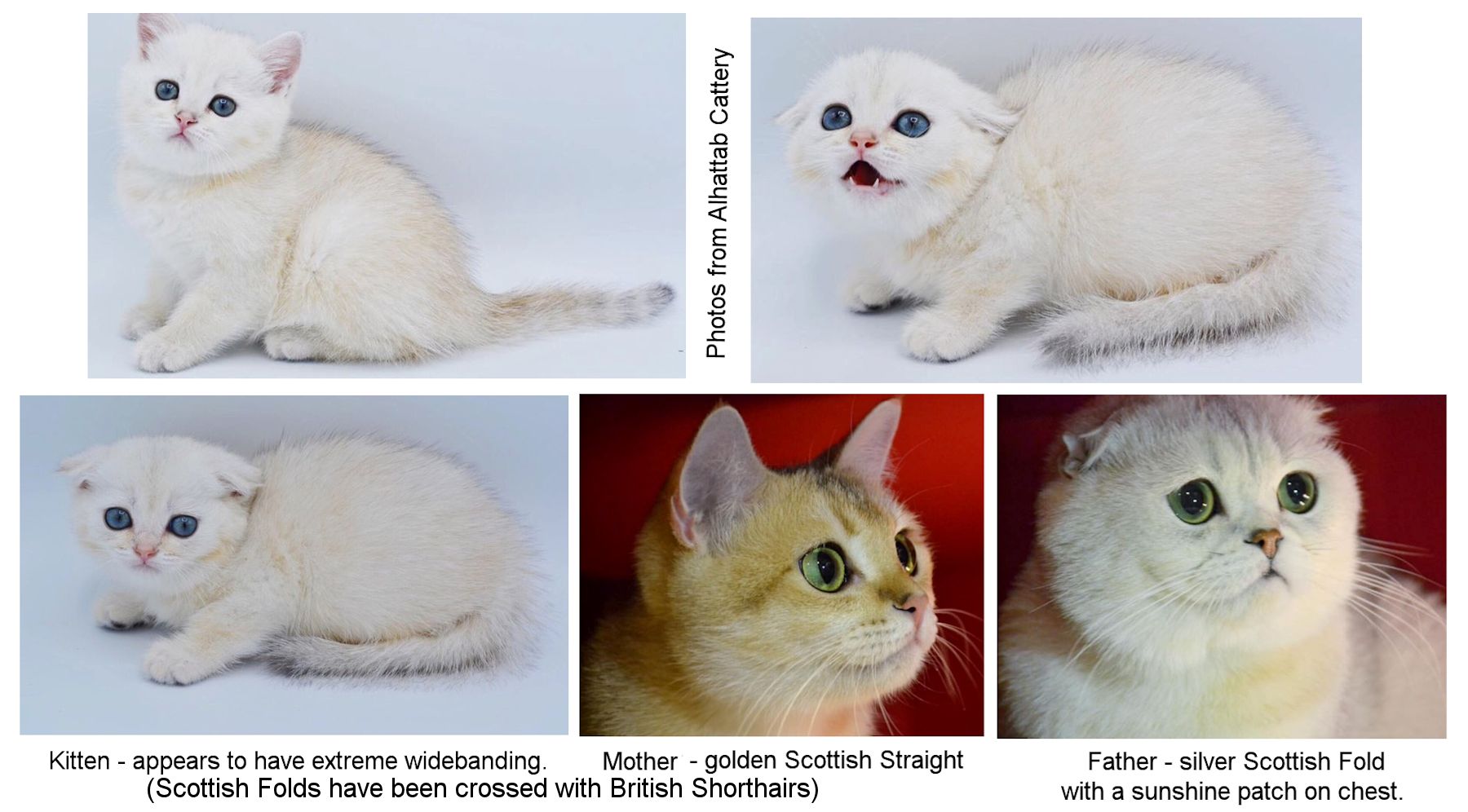
SIBERIAN GOLDEN (SUNSHINE)
See: Corin Gene: Sunshine and Sunshine-Silver ("Bimetal") Siberians
The Siberian is recognised in many colours and patterns. Some registries recognise the "golden series". This is not recognised as "golden" by Britain's GCCF. Siberian "Golden Tabby (with or without white)," Golden Tortie Tabby (with or without white)," "Golden Shaded" etc are not viewed as a genetic colour, but as an expression of Brown Tabby due to wide agouti banding on the hair shafts which limits the black banding and gives a warmer, brighter tone. This means that Siberian cats registered as "golden" by FIFE or TICA are re-registered as brown tabby (etc) when transferred into GCCF. The relevant EMS codes are ny22 for Black Golden Classic (blotched tabby) ny23 for Black Golden Mackerel and ny24 for Black Golden Spotted. Ticked tabby (code 25) is not permitted by all registries (GCCF in Britain do not permit the ticked tabby pattern).
Siberian breeders gave this colour the name "Sunshine" so that it could be investigated without confusing it with the Goldens born from lines with silver ancestry. "Sunshine" would refer to golden-coloured cats without silver ancestry. A study published in 2021 found that the "sunshine" phenotype in the Siberian breed was a mutation of the CORIN gene, representing the wbSIB (Siberian recessive wideband allele). Sunshine is the first "rufism" gene named and confirmed in cats.
In Persians, Exotics and British Shorthairs, golden seems to result from Wide band gene(s) and many of the cats have silver ancestors (dominant Inhibitor gene) because the wide band effect was selectively increased when breeding for pale chinchillas. There is a misconception that when a cat with a silver parent isn't silver, it must be golden by default. In Siberians, the Golden/Sunshine colour is inherited recessively. It brightens the agouti (ticked) areas of the coat. Where Golden/Sunshine occurs in cats with the "O" (red) gene, the red colour is brighter and the paws are lighter. The absence of pigment in the sunshine tabbies extends beyond the edges of the nose leather so they have no nose-liner and have whitish fur at the bottom of the nose.
BIMETALLIC SIBERIANS
Corin Gene: Sunshine and Sunshine-Silver ("Bimetal") Siberians

"Bi-metallic" is an informal term for a visual effect, while "sunshine" is the gene name. Sunshine is a CORIN gene mutation. In Siberian Cats, sunshine-silver produces the bi-metallic pattern. Some Siberian cats had both silver and golden areas of fur and were dubbed "bimetallic." The effect is greater than rufousing or breakthrough colouring sometimes seen in silver tabbies. In some cats the golden areas increased as the kittens matured.
BIMETALLIC BRITISH SHORTHAIRS
Martina Gottwald has found the bimetallic trait in some breeding lines. Although most German breeders prefer not to acknowledge it, it seems likely that some champion "golden" tabby and "shaded" may be genetically different, for example the sunshine or bimetallic trait.

See: Inhibitor Gene: "Bimetallic" British Shorthairs
CORIN GENE IN BENGALS
A CORIN mutation has been found in Bengals. Some Bengals (known as “whited pattern”) have a strongly counter-shaded pattern with very pale underparts and deep golden brown markings. (Publication due in October). The Toyger may also have this gene as it is derived from Bengals. The Ocicat has a similar pattern, but I have no information on the genetic basis.
RUFISM VS GOLDEN IN BRITISH SHORTHAIR/LONGHAIR, PERSIAN & EXOTIC
The most common debate (which can get really nasty) is that golden is just Rufism or is poor suppression of pigment by the inhibitor gene. Some go so far as to say there is no such thing as golden, it is just a fancy word for a black tabby. This is made worse because some breeders register and sell black tabbies as golden tabbies because it sounds fancier. Contributors to this page are helping collect DNA samples to unravel this and to develop a DNA test for Silver and Gold.
True Rufism – as opposed to Gold - is the incomplete dominance of silver over "non-silver", which shows up mainly on the undercoat, which should ideally be white everywhere. These areas of "non-silver" are often located chaotically - a stain on the neck, on the back, on the head. If yellowing is found on the hair tips, but not on the undercoat, this is not Rufism! Only homozygous silver does not give Rufism. Gold cats are genetically black, and have both eumelanin and phaeomelanin visible at the same time because these are laid down in alternating bands.
One Theory (not proven): Rufism is the predominance of phaeomelanin. In gold colours, breeders select animals where phaeomelanin (Rufism) predominates. In silver colours, selection is made for the exclusion of phaeomelanin and the production of eumelanin only. The silver gene has a greater effect on eumelanin and a lesser effect on phaeomelanin. When mating a gold cat to a silver one, the silver gene does not cope with the phaeomelanin zones in the hair resulting in areas of non-silver colour. These zones may be spots on the sides, back, muzzle, and paws. Sometimes there is a dorso-versal division where the chin, chest, and belly are golden colour (this colour division is seen on ticked cats such as Abyssinian). If there is a red zone on the tips of the hair, then this is not considered Rufism. Mating a cat selected for black pigments (that can be suppressed by the inhibitor) to a cat selected for red/gold pigments (which cannot be suppressed so well) gives unpredictable results. There is a "conflict of interest" between the colours! A lot depends on whether the silver parent is homozygous and how strongly the other parent expresses and passes on phaeomelanin.
RUFISM VS BIMETAL
Bimetallic is an informal term for a visual effect. For cats where silver and golden are expressed in a pattern like that of a black-and-tan dog. The chin, chest and underside (extending to part way up each side) are golden. The upper parts are silver. In BSH & BLH this may be an extreme form of Rufism giving a particular phenotype. Establishing a DNA test for Inhibitor and Wide Band will help understand this. A CORIN gene mutation has been identified as the wide-band gene in copper/light gold BSHL & BLH.
WOODS LAMP (UV LIGHT) TO IDENTIFY SILVER AND GOLDEN AREAS
One proposed method to separate Silver from Golden used the Woods Lamp (UV light). Such lamps in veterinary clinics determine the presence of ringworm. It was initially thought that in silvery colours, the fur closest to the skin, and that on the ears and muzzle glow blue. In golden colours the fur supposedly glowed pink/red. At first it was though that UV light could be used to differentiate between Golden and Rufism, but in Russia this method has now been discarded due to unreliable results.
BIMETALLIC-TYPE EFFECT IN AN AMERICAN SHORTHAIR
Sometimes the colour appears to change as the fur grows and may not be due to an extension gene mutation. This American Shorthair is genetically silver tortie but looks like brown/chocolate silver tabby or a tabby with mink/sepia colour restriction. She was born dark-coloured and the golden areas became prominent later. The father is a silver classic tabby (i.e. black marked) and the mother is cameo (red-silver) and white. Although the American Shorthair is accepted in all colours and has an open studbook, there is no known sepia (Burmese colour restriction) or chocolate in this cat’s pedigree. She was bred by Alhattab cattery in Kuwait and is CFA registered.
The inhibitor gene is less effective on red pigment than on black pigment, which means that a silver tortie can seem to have a mix of silver and golden background colour. The apparent brown colour could be due to an even mingling of red and black with a lot of rufousing, rather than clearly defined red and black areas. The father appears to have some tarnish (rufousing). However the development of the colour and the visual suggestion of a pointed cat is unusual. These come from Russian lines.
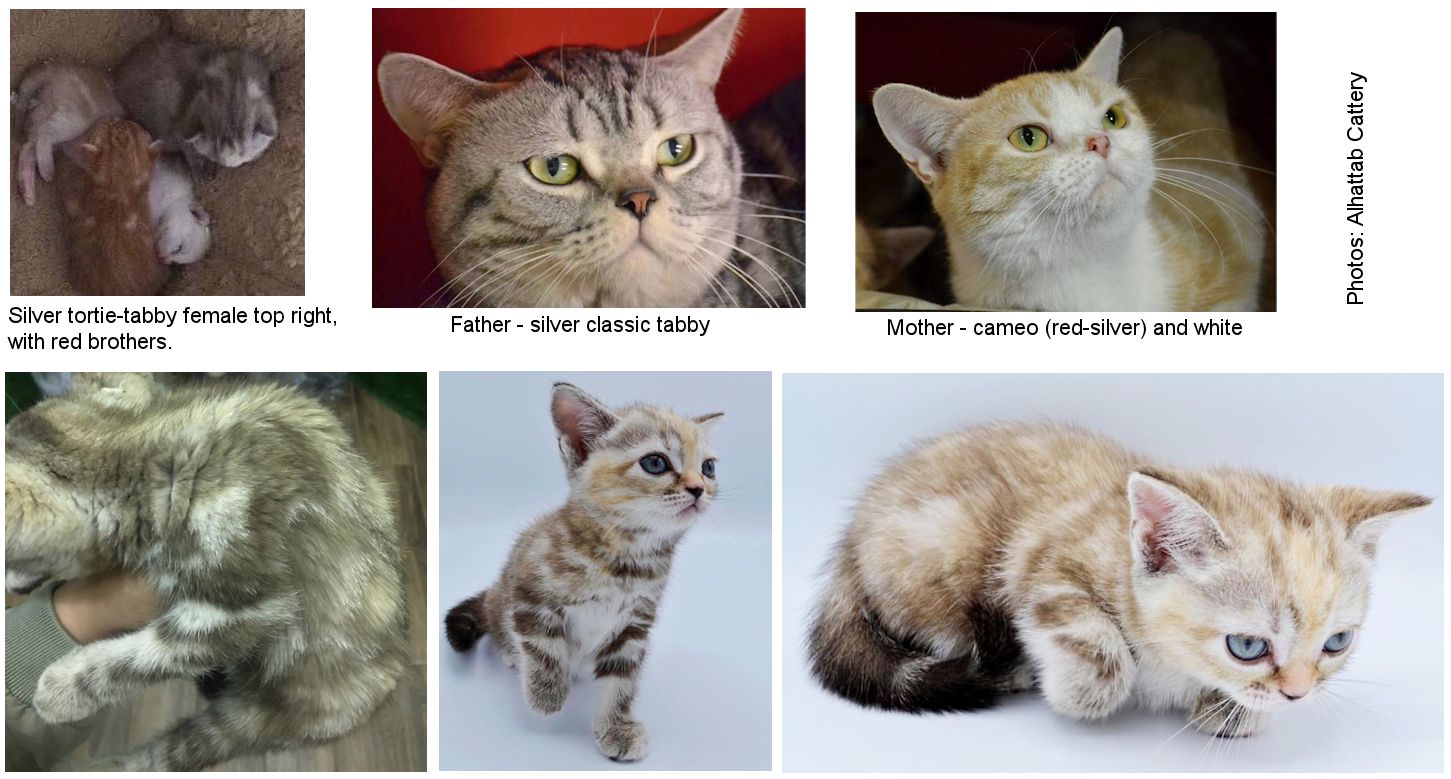
FOOTNOTES. SOME OLDER THEORIES
These theories are no longer current, but worth mentioning for historical purposes.
OLDER THEORY: SILVER BLEACHING AND ERASER GENES?
In addition to Inhibitor (silver), another gene is inherited. Wb works only with the agouti gene. What about another theoretical gene called (4 different names for same gene) Silver Bleaching (Sv), Eraser (Er), Unpatterned (U) or Bleaching (bl) which works with both Agouti and non-agouti? Let’s call it Unpatterned (U).
Non-agouti + Unpatterned + Wide Band – this cannot become Golden Smoke, but will be solid colour with unpigmented fur near the skin (which often happens).
Agouti + Unpatterned + Wide Band – golden phenotype.
What if U is a complex of polygenes? There is an older theory of silver (and golden) that involves 2 interacting genes called Silver Bleaching (cancels rufousing in eumelanin colours, but less so in phaeomelanin colours - leaving behind warmer tones) and Eraser (causes silver at the base of the hair).
Agouti + Silver Bleaching without Eraser - shaded and tipped cats with a coloured band, instead of a bleached band, near the skin. This is not seen in cats.
Non-agouti + Silver Bleaching without Eraser - cool-toned (unrufoused) solid colour cats.
Non-agouti + Silver Bleaching + Eraser - Smoke pattern.
If smoke cats heterozygous for both silver and eraser (sv and er) were bred together, they should produce some solid colour offspring (svsv erer).
If shaded or tipped cats heterozygous for both silver and eraser (sv and er) were bred together, they should produce some cool-toned full colour ticked tabby offspring (svsv erer) i.e. less rufoused than an Abyssinian.
Eraser + Silver Bleaching causes silver at the base of the hair.
Agouti + Eraser without Silver Bleaching (Er- svsv) – warm-toned pale ticked tabbies, golden base colour shade rather than a reddish one i.e. shaded goldens and they are only recognised in eumelanin (black-based) colours not in red-based colours. Red-based versions are visually similar to red or cream ticked tabbies. This theory means golden tabbies would result from breeding together silver tabbies that carry the recessive sv allele.
A golden tabby (svsv) with dominant Er would be golden tabby shell or shaded depending on the amount of pigment present. A golden tabby with only erer would not have depigmented hair roots.
Non-agouti + Eraser without Silver Bleaching (Er- svsv) - golden smoke, but golden smokes don't exist in reality. This means the Er + Sv theory is also flawed, or that these are not 2 genes that can be inherited separately.
OLDER THEORY: GOLDEN EPISTATIC GENE?
Another theory is the Golden Epistatic Gene or an "Ay" allele of the Agouti gene that is dominant over A. This is seen in gold agouti mice and sable dogs. It causes the formation of yellow-golden lower zone of the hair - with a black tip. An ideal golden chinchilla would be: Ay-TaTa ii UU WbWb (Epistatic Golden + Ticked Tabby + recessive inhibitor + Unpatterned + Wideband)
ADDITIONAL NOTES ON POSSIBLE GENOTYPES
In Siberians, gold is formed to a greater degree by expression of Agouti + Wb, while in the British, Persians, Exotics, the complex = Agouti + Wb + UU and possibly many more are involved. (UU means homozygous for hypothetical genes that change agouti banding). To get a fuller picture, it is necessary to compare gold in other tipped breeds
Good quality tipped cats are ticked tabbies, but they have the lower dark part of the hair erased of colour by Wb + UU. This means tipping is a kind of ticking. Another observation is that two homozygous ticked tabbies do not produce tipped offspring.